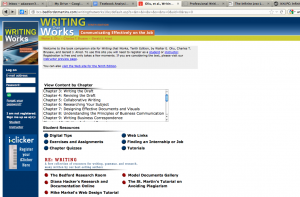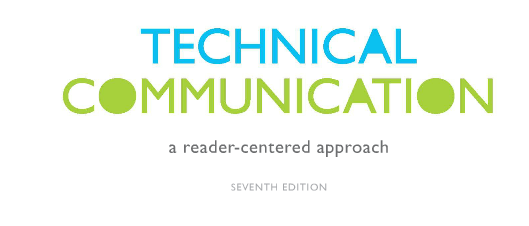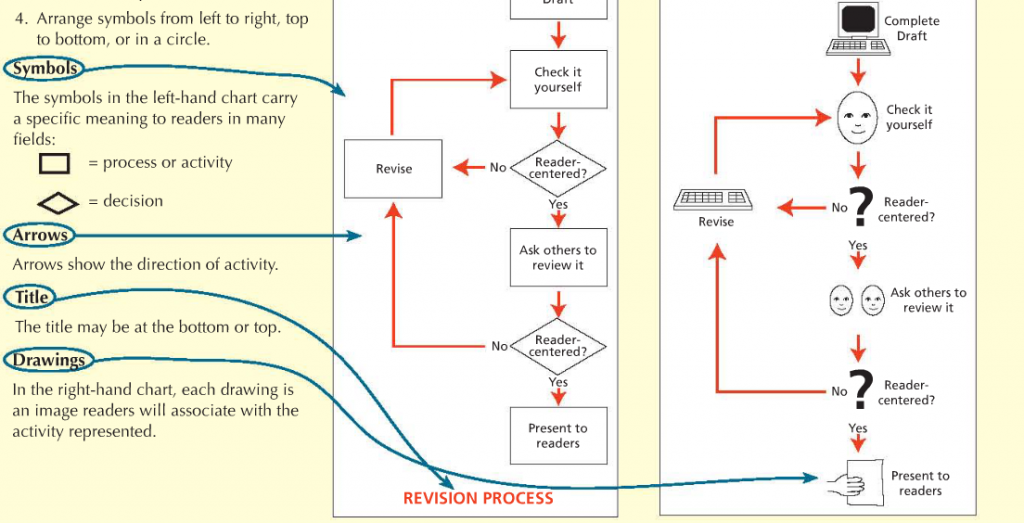Textbook Analysis: Writing That Works, Tenth Ed.
Writing That Works, Tenth Edition. Walter E. Oliu, et al.
A note: Like crafting an in-office memo or company wide e-mail, critiquing a textbook relies on many factors: context, tone, style, etc. Last class meeting, Rachel expressed her neutrality for the cheesy albeit effective use of goofy images and accompanying speech bubbles from a text we shared in another course. While cheesey, this pedagogic technique is an example of a feature I value in a textbook. So, because the way textbooks choose to instruct is subjective, I’ll be using a concrete criteria for which to critique Writing That Works. For this review, I’ll examine WTW beneath the backdrop of the ENGL 304 Syllabus
INTRODUCTION
What separates WTW from other business writing textbooks lies in its ability to develop in fine detail not just the mechanics of professional communication mainstays (resumes, letter writing, memos), but their designs, their quirks, and the culture in which the circulate. The text has many strengths, but most salient is its ability to instruct in a way that considers these genres and documents as a means to an end: interaction among humans. While it spends many pages clarifying the obvious (the importance of white space in Ch. 7) and the not so obvious (grant and research proposals in Ch. 13), WTW stresses that adherence to accepted and formal designs, documents, and other ways of information exchange is perhaps the greatest signifier of productive and healthy business writing.
To achieve this, Oliu and the gang divide WTW into four parts:
- The Writing Process
- Essential Skills: Collaboration, Research, and Design
- Writing at Work: From Principle to Practice
- Revision Guide: Sentences, Punctuation, and Mechanics
Beyond this division, sections are subdivided by chapters until section four. The third section, with nine of the the text’s sixteen chapters, dominates the bulk of the book. This third section offers practical guidance for at-work writing is stressed (proposals, presentations, even job hunting). Proceeding to the final part of the book, section four serves as a reference for polishing sentence level prose by discussing proofreaders’ marks, mechanics and tips for ESL wrtiers.
WRITING PROCESS (CHs. 1-4)
WTW stresses purpose-driven and audience-aware writing. In this first section, WTW discusses (1) how to compose the cornerstones of business communication like memos, letters, and proposals. Plenty of visuals are provided. To be sure, this is the text’s bread and butter for instruction: use many visuals with marginalia to reinforce the text written before it. (2) WTW encourages “writing systematically.” Claiming that process will produce helpful work documents, WTW adores processes like outlining, brainstorming, and checklists.
RHETORIC & PERSUASION
Last week, it seemed that one common criterion for evaluating the general quality of a text book was the use or appearance of the word “rhetoric.” Like a few other texts considered then, WTW lists the use of “rhetoric” only once (in reference to avoiding rhetorical questions within professional communication). Because WTW is a text designed for the business writing classroom, perhaps the word would be even more useful here rather than technical writing textbooks. To be sure, much of the material used in WTW focuses on saving face and establishing credibility (ethos) while persuading a co-worker or authority figure (pathos) that the new plan to change a practice or policy is worth their time (logos). Ultimately though, Oliu and company effectively achieve introducing the reader to the knack of rhetoric without saying as much.
VISUALS AND ORAL COMMUNICATION (CH. 7)
Not as an illustration, but as a kind of visual affect, WTW uses color and colored text boxes to spice up and organize the text. Orange is used for headings and as a background colors to differentiate between the meat of the text (ultimately, dos and don’ts) and auxiliary information (“Voices In the Workplace,”Ethics Notes”). As mentioned, WTW heavily relies on visuals to instruct. Clearly marked (eg., Figure 7-9), the graphic element of WTW is mostly always used in antiphony with the text. The less than ideal student who considers reading a chore will benefit from this feature. Of course, the illustrations also provide quick, concrete examples of document format, tone, style.
RESEARCH AND WRITING TECHNOLOGIES (CH. 6)
Nested in the text’s second section, Chapter 6, “Research Your Subject” guides the on-the-job researcher from very beginning raw data collection to polished product. From interview tips (“Be pleasant but Purposeful”) and designing a questionnaire (“Keep it as brief as possible”) to library and online usage (Ebscohost), WTW also provides metasearch engines and subject directories (see below) for the researcher.
Beyond the research process, WTW stresses the ethics of citation and provides clear and useful APA and MLA citation guides marked by colored margins for easy side-of-the-book findability.
DOCUMENT GENRES AND TYPES OF WRITING
Like instructing the aforementioned business communication mainstays, WTW gives consideration to a surprisingly wide range of genres and types of writing. With the exception of Twitter (which might not be germane considering what kind of business writing is desirable), WTW is brilliantly up-to-date re: modes of workplace communication. From medium selection to the appropriateness of when an instant message conversation should happen, WTW covers the obvious genres to the less obvious (eg., transmittals).
ELECTRONIC COLOPHON
The ancillary companion to the text takes a few days for registration. If not registered, the online element to WTW is unremarkable and ultimately not very helpful. To boot, there’s
nothing to write home about in terms of design:

The online component (unregistered) is really only helpful for instructors to assign quizzes and exercises. The tutorials link is somewhat helpful. Here, a student can access entry-level web design and online research tips.
WITH ENGL 304 (CHs. 8-15)
In the business writing classroom, I can reasonably see WTW approached chronologically. As WTW might be applied to WVU’s ENGL 304 it most certainly fits the bill (it is, in fact listed among the suggested ENGL 304 textbooks for instructors. But in accordance to the syllabus, approaching the text from front to back might not be putting it to its best use. Its scope and length are just too much. However, it would be very useful for ENGL 304′s two major processes: “The production of a professional writer’s portfolio and the production, with one other student, of a proposal and presentation project.” In this light, WTW is a shoe in. However, one process of the presentation project, the Rhetorical Analysis Memo, would certainly be arhetorical if this text was used, that is, it wouldn’t use the three rhetorical key words and their modes of meaning we’ve come to know and love.
Pg. 5 of the 304 syllabus says, “Students who have completed English 304 should be able to:”
1.“Apply strategies for analyzing professional writing contexts…”
2. “Compose and design documents…”
3. “Apply rhetorical arguments…”
4. “Conduct research and analyze data” with “proper methods of documentation” and to
understand ethics within the realm of research
5. “Know and apply composition methods and document design strategies…”
Broadly put, the goals amount to this: English 304 must be rhetorical. That is, English 304 must pay attention not only to what students should write, but to how and why writing happens in specific contexts for specific purposes. While WTW doesn’t approach making meaning and establishing credibility under the guise of “rhetoric,” it does an exceedingly good job of instructing them. Again, using WTW for the instruction of Aristotelian rhetoric may be a misstep, but supplements like hand outs or in-class lectures on the topic of rhetoric don’t seem too far out of reach.





